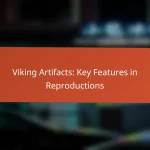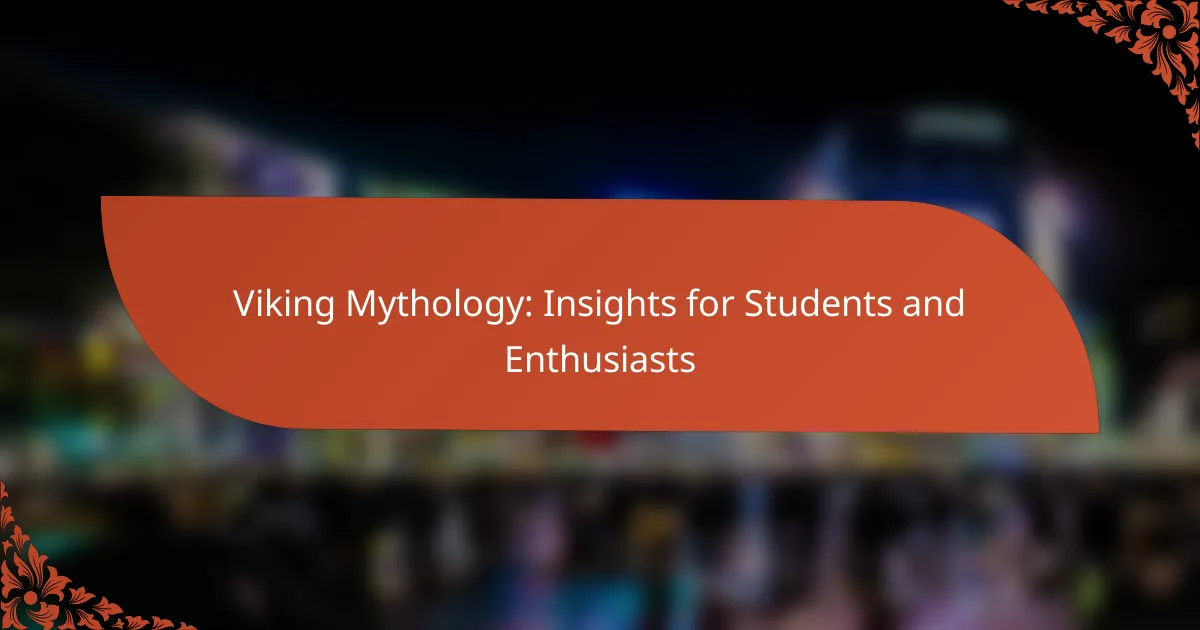Viking mythology is rich with key deities such as Odin, Thor, Freyja, Loki, and Frigg, each representing vital aspects of life and nature. Their stories, filled with adventures and conflicts, reveal profound themes of creation, loss, and the balance between order and chaos. Today, these ancient gods continue to influence modern culture, inspiring art, media, and a resurgence of interest in Norse pagan practices.
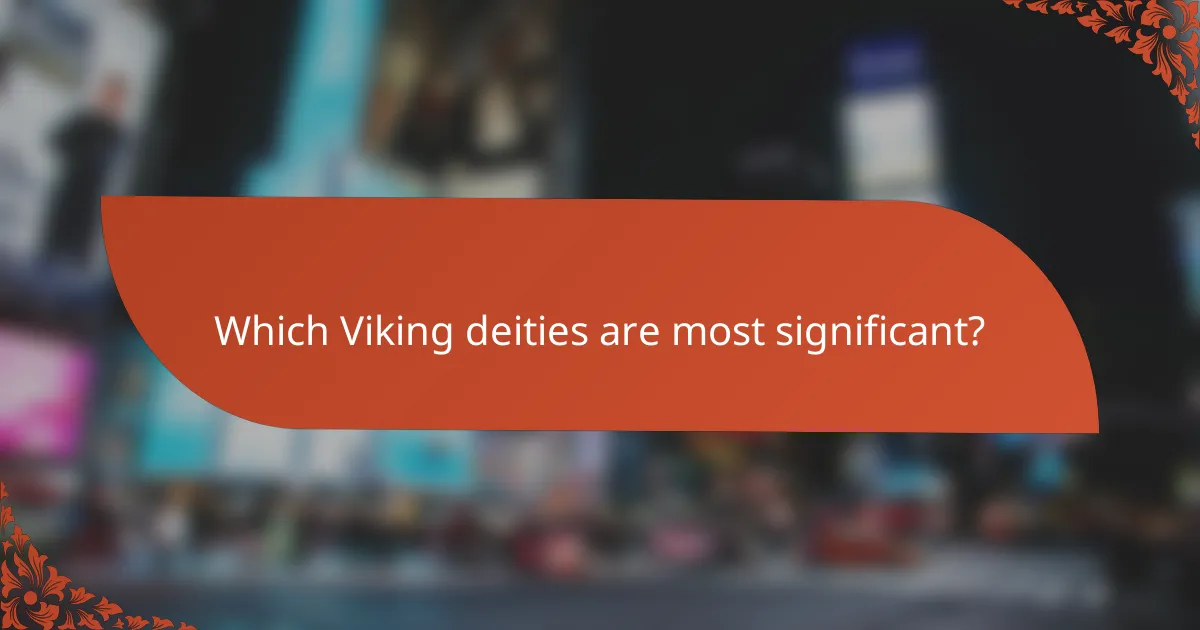
Which Viking deities are most significant?
The most significant Viking deities include Odin, Thor, Freyja, Loki, and Frigg. Each of these gods and goddesses plays a crucial role in Norse mythology, embodying various aspects of life, nature, and human experience.
Odin: God of wisdom and war
Odin is revered as the chief of the Aesir gods, symbolizing wisdom, war, and death. He is often depicted as a one-eyed figure, having sacrificed his eye for knowledge, and is associated with the pursuit of wisdom through sacrifice and experience.
As a war deity, Odin inspires warriors and is believed to choose those who will die in battle, guiding them to Valhalla. His quest for knowledge leads him to various realms, where he learns from other beings, including giants and seers.
Thor: God of thunder and protection
Thor is the god of thunder, known for his immense strength and protective nature. He wields the hammer Mjölnir, which symbolizes his power to protect humanity from chaos and evil forces, particularly the giants.
Thor’s character embodies bravery and loyalty, making him a favorite among the Viking people. His stories often depict him battling giants and safeguarding the gods and humans alike, reinforcing his role as a protector.
Freyja: Goddess of love and fertility
Freyja is the goddess of love, beauty, and fertility, celebrated for her nurturing qualities and connection to the earth’s bounty. She is often associated with love spells and the arts of magic, particularly seidr, a form of sorcery.
As a warrior goddess, Freyja also claims the souls of those who die in battle, sharing them with Odin. Her dual nature as both a nurturing figure and a fierce warrior highlights the complexities of femininity in Viking culture.
Loki: God of mischief and chaos
Loki is known as the trickster god, embodying mischief, chaos, and unpredictability. His actions often lead to trouble for the gods, but he also plays a crucial role in their stories, sometimes aiding them with his cunning.
Despite his chaotic nature, Loki’s character is complex, showcasing both positive and negative traits. His eventual betrayal of the gods leads to significant consequences in Norse mythology, culminating in Ragnarok, the end of the world.
Frigg: Goddess of marriage and motherhood
Frigg, the wife of Odin, is the goddess of marriage, motherhood, and domesticity. She represents the ideal of family and is revered for her wisdom and foresight, often associated with the protection of home and hearth.
Frigg’s nurturing qualities make her a central figure in the lives of the gods, and her ability to see the future adds depth to her character. She is often invoked in matters of love and family, emphasizing her importance in Viking society.

What are the main stories associated with Viking deities?
The main stories associated with Viking deities revolve around their adventures, conflicts, and relationships that highlight their significance in Norse mythology. These tales often illustrate themes of creation, loss, and the struggle between order and chaos, showcasing the complex nature of the gods and their interactions with humans and each other.
The creation myth involving Odin and his brothers
The creation myth in Norse mythology begins with Odin and his brothers, Vili and Ve, who are credited with forming the world from the body of the first being, Ymir. After slaying Ymir, they used his flesh to create the land, his blood to form the seas, and his bones to create mountains. This myth emphasizes the themes of sacrifice and transformation, as the gods shape the universe from chaos.
In addition to creating the physical world, Odin and his brothers also crafted the first humans, Ask and Embla, from trees. This act signifies the gods’ role as creators and their deep connection to humanity, which is a recurring theme in many Viking stories.
Thor’s journey to retrieve his stolen hammer
Thor’s journey to retrieve his stolen hammer, Mjölnir, is one of the most famous tales in Viking mythology. When the giant Thrym steals Mjölnir and demands the goddess Freyja as his bride in exchange for its return, Thor disguises himself as Freyja to infiltrate the giant’s realm. This story highlights Thor’s bravery and cunning, showcasing his determination to protect Asgard and its inhabitants.
The journey also illustrates the importance of community and collaboration, as Loki accompanies Thor and aids him in his quest. Their adventures reflect the themes of loyalty and resourcefulness, essential traits for the Viking culture.
Freyja’s search for her lost necklace
Freyja, the goddess of love and fertility, embarks on a quest to recover her prized necklace, Brísingamen, which has been stolen. This necklace symbolizes her beauty and power, and its loss represents a significant blow to her status among the gods. Freyja’s determination to reclaim it showcases her strength and resilience.
In her search, Freyja encounters various challenges and must negotiate with other deities and beings, emphasizing the themes of sacrifice and the lengths one will go to for love and beauty. This story reinforces Freyja’s role as a powerful figure in Norse mythology, embodying both femininity and strength.
Loki’s role in the death of Baldr
Loki plays a pivotal role in the tragic death of Baldr, the beloved god associated with beauty and light. After a prophecy foretells Baldr’s death, Loki deceives Baldr’s blind brother, Höðr, into killing him with a mistletoe arrow, the only substance that could harm Baldr. This act of betrayal highlights Loki’s complex character as both a trickster and a catalyst for chaos.
Baldr’s death has profound implications for the gods, leading to a series of events that ultimately contribute to Ragnarok, the end of the world in Norse mythology. This story emphasizes the themes of fate, loss, and the interconnectedness of actions and consequences within the mythological narrative.
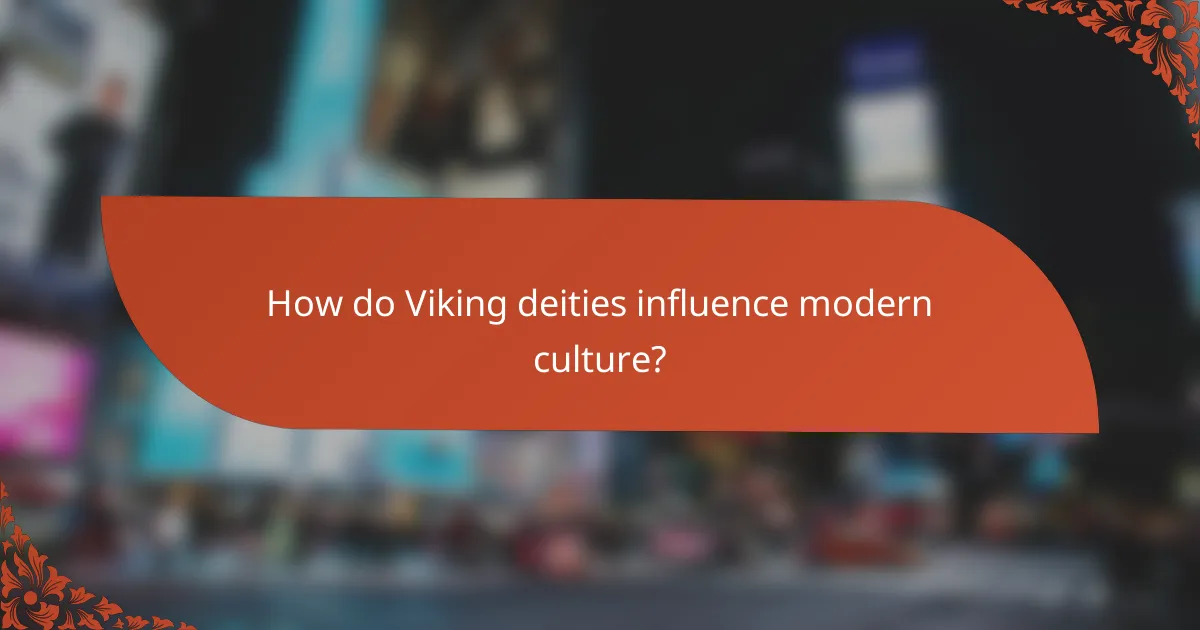
How do Viking deities influence modern culture?
Viking deities significantly influence modern culture through their representation in various forms of media, the revival of Norse pagan practices, and their symbolism in art and fashion. These ancient figures resonate with contemporary audiences, reflecting themes of heroism, nature, and spirituality.
Representation in literature and film
Viking deities are frequently depicted in literature and film, shaping narratives around heroism and mythology. Works like Neil Gaiman’s “Norse Mythology” and the Marvel Cinematic Universe’s portrayal of Thor have brought these characters to mainstream attention, often blending traditional stories with modern storytelling techniques.
Films such as “The 13th Warrior” and series like “Vikings” further explore the lives and adventures of these gods, introducing audiences to their complex personalities and relationships. This representation not only entertains but also educates viewers about Norse mythology.
Impact on modern paganism and Norse religion
Modern paganism, particularly Heathenry, draws heavily from Viking deities, with many practitioners honoring gods like Odin, Thor, and Freyja in rituals and celebrations. This revival of Norse religion emphasizes a connection to nature, ancestral heritage, and community.
Festivals such as Yule and Midsummer are celebrated by these communities, often incorporating traditional practices and beliefs. This resurgence highlights a growing interest in spirituality that resonates with contemporary values of environmentalism and personal empowerment.
Symbolism in contemporary art and fashion
Viking deities have become powerful symbols in contemporary art and fashion, often representing strength, resilience, and a connection to heritage. Artists incorporate motifs from Norse mythology into their work, using imagery of gods and mythical creatures to evoke a sense of identity and cultural pride.
Fashion brands have also embraced these symbols, with designs featuring runes, Thor’s hammer, and other Norse elements. This trend reflects a broader cultural fascination with ancient myths and their relevance in modern life, appealing to those seeking authenticity and meaning in their personal style.

What are the key attributes of Viking mythology?
Viking mythology is characterized by its rich tapestry of gods, goddesses, and cosmic elements that explain the universe’s structure and human fate. Central to this belief system are themes of fate, the interconnectedness of worlds, and the importance of rituals to appease deities.
Cosmology: Nine worlds and Yggdrasil
The cosmology of Viking mythology consists of nine worlds that are interconnected through Yggdrasil, the World Tree. Yggdrasil is an immense and central sacred tree that connects the realms of gods, humans, and other beings, symbolizing the unity of existence.
The nine worlds include Asgard, home of the Aesir gods; Midgard, the realm of humans; and Hel, the land of the dead. Each world has its own unique characteristics and inhabitants, contributing to the overall narrative of Viking beliefs.
Concept of fate and the Norns
In Viking mythology, fate is a powerful force governed by the Norns, three female beings who weave the destinies of gods and humans alike. They are often depicted as Urd (the past), Verdandi (the present), and Skuld (the future), emphasizing the inevitability of fate.
The Norns’ influence highlights the belief that while individuals can strive for greatness, their ultimate destinies are predetermined. This concept encourages acceptance of one’s fate and the understanding that life is a complex interplay of choices and consequences.
Rituals and sacrifices to deities
Rituals and sacrifices were integral to Viking worship, aimed at gaining favor from the gods. These practices often included offerings of food, drink, and even animals, performed during significant events or seasonal changes.
Common rituals involved blóts, which were sacrifices to deities, and sumbels, a ceremonial drinking ritual that honored gods and ancestors. Engaging in these practices was believed to strengthen the bond between humans and the divine, ensuring protection and prosperity.
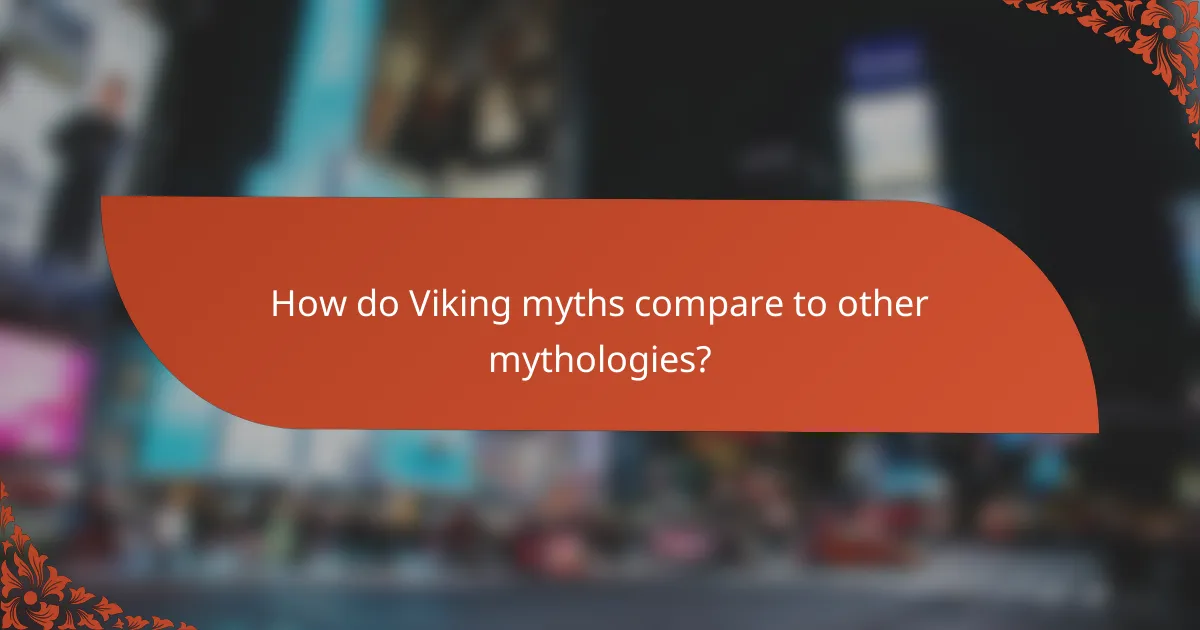
How do Viking myths compare to other mythologies?
Viking myths share both similarities and differences with other mythologies, notably Greek and Roman. These comparisons highlight unique cultural values and storytelling techniques that shaped the Norse worldview.
Similarities with Greek mythology
Both Viking and Greek mythologies feature a pantheon of gods and goddesses who embody various human traits and emotions. For instance, just as Zeus is known for his authority and power, Odin represents wisdom and war among the Norse deities. Additionally, both mythologies include epic tales of heroism, divine intervention, and the struggles between gods and mortals.
Another similarity lies in the presence of mythological creatures. In both traditions, beings such as giants and monsters play significant roles, often challenging the gods and heroes. This reflects a shared theme of chaos versus order, where deities must confront external threats to maintain balance in the universe.
Differences from Roman mythology
Viking mythology differs from Roman mythology primarily in its focus on fate and the afterlife. Norse beliefs emphasize concepts like Ragnarok, a prophesied end of the world, and the importance of individual destiny, while Roman myths often center around the glory of the state and the favor of the gods in civic life. This reflects the more communal and militaristic nature of Viking society compared to the civic-oriented Roman culture.
Furthermore, the portrayal of deities varies significantly. Norse gods, such as Thor and Loki, are often depicted with complex personalities that include flaws and moral ambiguity, while Roman gods tend to be more idealized and representative of societal values. This difference illustrates how each culture’s mythology serves to reinforce its own social norms and ideals.





